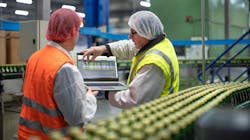The United Nations has warned that half of the global population could face water scarcity by 2025, while intense water shortages could displace 700 million by 2030. This must serve as a lightning bolt to the industry to do everything possible to conserve this precious resource. Across mining, petroleum, chemical and food and beverage manufacturing, for example, water is a core asset. It takes 250,000 liters to produce a ton of steel and 32 liters to make a single chip for a laptop or smartphone.
At the same time, industrial sites are often located in water-stressed areas. Water scarcity currently affects around 50% to 60% of operating mines and 80% to 90% of new mines are built in water-scarce areas. In California, oil and gas operations consume upwards to 1 trillion gallons of water for extraction and refining annually.
Industry must not only find a way to use less water but also ensure that harmful wastewater discharge is dealt with sustainably. This duality of challenges — reduction and zero water discharge — are core to ensuring a sustainable water industry and can only be met through innovation.
Reduction and reuse within a circular model will prove vital to solving this dual challenge. With the regulatory framework and investment to match, the digitization of industrial water represents a huge opportunity to achieve sustainable practices while also driving down costs. To stem the flow of freshwater shortages and avoid polluted discharges impacting the water bodies, sustained investments in technology are key. Here we explore how today’s technologies answer this dual challenge to ensure a sustainable future.
Reducing water consumption = Positive impact on energy and environment
Reducing water use is a core tenet of sustainable production, but you can only reduce what you can measure. Particularly with regard to water, it is often said that we are rich in data, but poor in useful information. Technologies such as digital twins, machine learning and the Internet of Things (IoT) go further than raw data to analyze, interpret and deliver actionable insight that drives water use reduction. Water sustainability strategy relies on infrastructure that enables data transparency and sustainability starts with the ability to extract performance data from the physical infrastructure that supports core operations.
For example, Schneider Electric’s Normandy plant, recognized by the World Economic Forum as a “sustainability lighthouse” employs industrial Internet of things (IIoT) sensors connected to digital platforms to unlock data that drive energy and water efficiency. Its zero-reject water recycling station, connected to cloud analytics and monitored by artificial intelligence (AI), has led to a 64% reduction in water. As part of a holistic efficiency strategy, digital transformation across the plant has also reduced material waste by 17% and CO2 emissions by 25%.
Reduction isn’t simply about reducing the water used in processes but also mitigating the impact of faulty assets and leaks. Proactive asset management through connected technologies and digitalization shifts operations, maintenance and emergency responses from reactive to predictive, providing visibility into ageing or faulty equipment that may be leading to leaks or losses.
Strategies to reuse wastewater
After reducing water use, the second challenge is that of zero water discharge, ensuring the water that has been used is not simply discarded. Unfortunately, large volumes of untreated wastewater are still released into rivers, oceans and streams, potentially affecting the environment and public health.
In the industrial realms, water and wastewater treatment is required to provide the right quality of water for the industrial process and to remove harmful materials like lithium, cadmium, phosphorus and toxic solvents. Wastewater treatment plants capture heavy metals and hazardous substances that may have polluted the water before directing it for reuse. Since the process of water purification depends on the energy and infrastructure available to the manufacturer, solutions addressing the nexus between treatment processes and energy are vital.
Digital technologies finally allow us to reuse water and wastewater and grey water that could also be used in some industries. For example, Brazil’s largest wastewater treatment plant, Aquapolo currently uses Schneider Electric’s EcoStruxure solution to increase operational efficiencies. Aquapolo is dedicated to producing recycled water for industrial use, a sustainable solution that recycles sewage to meet growing industrial demand, while conserving scare water resources of Sao Paolo. For every liter of recycled water they produce, a liter of drinking water can be saved, ultimately reducing 15% of total costs of production. Where treated water can be reclaimed, it can then be used in place of scarce freshwater in other processes.
To make the most from water availability and reusability, it comes back to understanding the importance of connected data and analysis. The payback is clear, for example, in the mining industry for every $1 invested in digital solutions for water management at a mine site, an operator can get at least $4 or $5 back in savings.
Industrial companies, and specifically the water and wastewater sector, have a fundamental role when it comes to addressing the growing demand for water. Reinventing sustainability in water cycle management entails optimizing energy efficiency, increasing circularity through connections with other sectors and providing incentives for decarbonization, as well as being deeply involved with the community where one operates. Water conservation in quantity and quality is crucial to sustaining efficient resource use throughout the water cycle and true water stewardship.
Carmen de Miguel is an engineer with more than 20 years of experience in water, including 15 with Telvent and Schneider Electric. She has a background in simulation and advanced applications for water, wastewater, and hydrology. Carmen started her career at two water utilities in Spain, then moved to hydraulic consultancy working for Danish Hydraulic Institute, before joining Telvent/Schneider Electric where she has worked in project execution and business development, R&D, as solutions manager and architect.
About the Author
Carmen de Miguel
Water & Wastewater Segment Strategic Manager at Schneider Electric
Carmen de Miguel is the Water & Wastewater Segment Strategic Manager at Schneider Electric.
